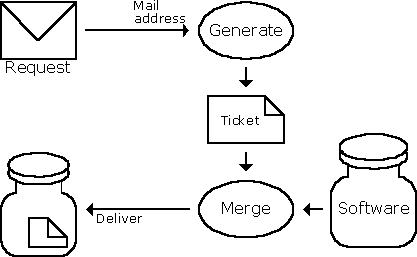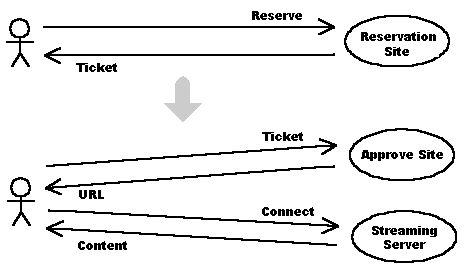
The Certlet Ticketing SystemTM allows easy building of a digital ticketing system for private use.
The Certlet Ticketing System is for issuing and approving tickets digitally signed by mini-style public key certificates called certletTM. It is applicable to many areas: software licensing, reservation service, contents viewing authorzation and others.
You can build and operate an easy-to-use digital ticketing system using certlets. You may have abandoned building of such a system because use of full-specification X.509 certificates are too costly, requires heavy labour and long preparation time, or because of technical difficulty and absence of experts of this area.
A ticket (and certlets used to sign the ticket) take the Internet mail header format. This is contrary to full-specification X.509 certificates which use binary format. The latter can not be examined by human eyes.
X-Certlet-Signature: MCwCFCocKhEjgbq19B0Xi9... X-Certlet-Digest: B8lDi4TFKN38re0J7jmc91Mnk... X-Certlet-Name: Chang, Peter X-Certlet-Address: chang@kobu.com X-Certlet-NotBefore: 2003/10/25 00:00:00 X-Certlet-NotAfter: 2003/11/25 00:00:00 X-Certlet-IssuerName: HonkyTalk X-Certlet-IssuerAddress: honkyvoice@kobu.com X-Certlet-IssuerDigest: 3InX2T03qE3nEiHxCWt... X-Certlet-IssuedOn: 2003/10/15 10:09:34 (This example is slightly modified for easy understanding and not a real one.)
The size of a ticket depends on the amount of application-specific data. But, for an example, a typlical HonkyVoice ticket at hand is just 384 bytes and can be compressed to 249 bytes (35% reduction) using the standard ZIP compression.
The following are example applications of ticketing by certlets. Of these, software licensing is actually used in HonkyVoice.
Software licensing is done through tickets issued to users.
For example, in HonkyVoice case, a ticket is issued to the user's mail address and digitally signed with the private key held by the software publisher, in this case Kobu.Com.
HonkyVoice offers two methods of ticket distribution.
In case of mail distribution, a ticket is automatically generated, packed in the HonkyTalk runtime file (JAR file) with signer's certificats, and replied to the user.

In case of web download or CD-ROM distribution, the ticket is not included in the JAR file. The ticket server generates and distributes the ticket on the first invocation of HonkyVoice by that user.

An example of reservation services is video or music streaming.
A streaming server has a certain limit to the number of users who can simultaneously connect to it due to licensed number of viewers, available network bandwith or machine power.
Think of requesting a viewer to make a prior reservation so that the number of users who can connect to the server at a certain time can be limited. As a result, no users will be disappointed due to service rejection or poor service quality.
A potential viewer will visit a reservation web site, choose a content and viewing date and time. A ticket is issued to the viewer. The upper limit of viewers in a certain date and time can be limited by the number of tickets issued.
On a reservation data and time, only a viewer having a right ticket can be brought to the streaming server. This can be done by first directing a ticket holder to an approval site then inviting only an approved viewer to the streaming server.


Copyright © 2008 Kobu.Com. All rights reserved.
Updated 2008 Oct 13
Home